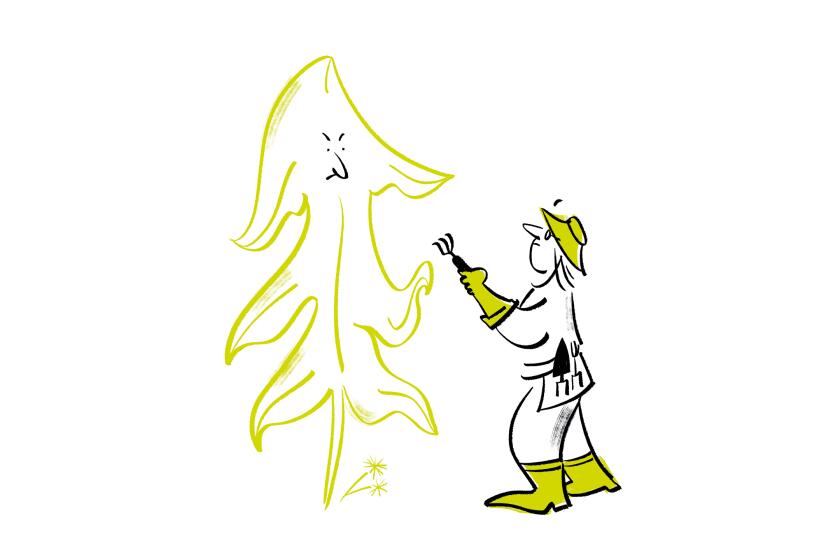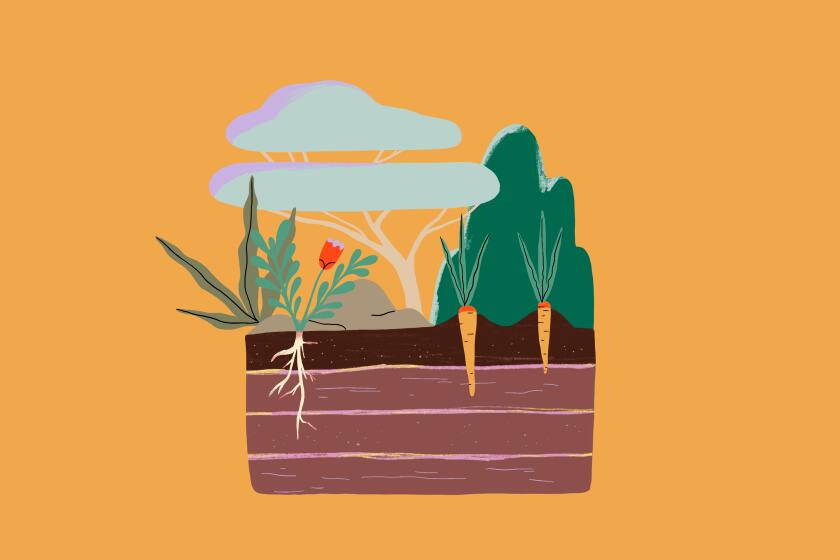Why vinegar might be your secret weapon to fighting weeds
- Share via
Weeds are the worst — probably the most discouraging aspect of gardening.
For instance, you clear a garden space, plant your beautiful flowers and/or veggies, and return a week later to discover weeds have taken over the entire bed. Left unscathed, they fuel fires in the fall and cause people to avoid going outside rather than stare at their overgrown yards.
I did not escape childhood unscathed by the dreaded chore of weeding. My desperate father promised his children a penny for every weed we pulled off our massive, overgrown slope, and I went after the job with a fever, counting my riches with every yank. That evening, when I presented my heaping bag of weeds and demanded $50, my dad was horrified until he realized I had basically grabbed handfuls of leaves and yanked. “You’ve got to get the roots,” he said sternly. “I’m not paying for leaves.”
Those weed fabrics and barriers that you just spent the weekend putting down?
Weeding wasn’t as fun — or profitable — after that.
So, yeah, weeds are a bummer, but here’s the truth: Weeds are a given in gardening, a regular chore, and this is prime weed season in Southern California. After our week of almost continuous rain earlier in the month, the awakened weeds are growing with vigor, which means you must spring into action now, before they flower and seed and take over completely.
Courage, gardeners, courage! The work you do now will pay dividends later this summer and fall. Don your gloves, sharpen your swivel or diamond hoes, rev your weed whackers and get to work. It will likely take a good part of a day (unless you have acres), but when you’re done, reward yourself with a cool “quarantini” and admire your work. The results will be worth the pain.
Gardeners, take a deep breath. We’ve made a list of 10 garden tasks that can help save your sanity now and make the coming months much more pleasant.
Plus, getting down and dirty with the weeds can tell you a lot about your soil, says Douglas Kent, an ecological land manager, adjunct professor at Cal Poly Pomona and author of several books about California-friendly gardening and fire-resistant landscaping.
“Weeds are mother earth’s response to changes in the environment,” Kent said. “Every weed only grows in certain environments, so your weeds can be telling you that your soil has too much nitrogen or too much salt, depending on what you have. If you want to really get rid of it, you need to change its environment.”
Nut grass, for instance, thrives in soil with overly wet, acidic soils with low oxygen, meaning it’s likely clay or heavily compacted, which is why it’s often found growing in waterlogged sections of compacted lawns.
One of Kent’s clients had a nut grass infestation after creating a California-friendly garden of native and drought-tolerant plants. Unfortunately, the soil was compacted and watered too frequently, he said. Kent’s solution was to turn off irrigation to the garden, keep people from walking on the soil, and in two months, the soil became more alkaline (less acidic) and the nut grass disappeared. “If you do it properly, you won’t find nut grass in a California-friendly garden,” he said. “But if you don’t read the signs, you’re doomed to a cycle of failure.”
1. Get ‘em young
Don’t wait until your weeds are thigh high. Tender, shallow-rooted weeds are easier to pull or scrape, but you definitely want to knock your weeds down before they flower and shoot off seeds that will lead to many more of the same weeds and an unending cycle of misery.
So don’t just walk away after planting your garden. Plan to visit at least once a day to check for pests, pull a few weeds or make sure it’s getting properly watered. In this case, an ounce of prevention is worth 10 pounds of miserable cure.
2. Cover up
Give your weeds a run for their money by growing ground-cover type plants that spread aggressively, such alyssum, California poppies, forget-me-nots, yarrow, geraniums, gazania and even wild strawberries. And cover your weeded areas with a thick, woody mulch that’s at least 4 inches deep, to protect the soil from incoming weed seeds.
“Coarse mulch out of the back end of a chipper is perfect for weed-suppressing mulch because it won’t compact,” Kent said.
Lasagna mulching is another technique that essentially smothers large sections of nut grass or other weeds, and experts say it’s effective at eliminating those plants. However, if you’re striving for a garden of California native plants, Kent doesn’t recommend lasagna mulching — basically covering the soil with cardboard and then a thick 6- to 8-inch layer of wood chips or other mulch — because it makes the soil too rich.
“Those soils with high nutrients are good for vegetables, cut flowers, roses and all your ornamentals,” Kent said, “but if you want to create a true scrub or chaparral environment [for California native plants], you want a neutral Ph and drier soil with lots of oxygen, like sandy soils that aren’t compacted.”
Skeptics were plentiful when L.A. Arboretum expert Leigh Adams first used waste cardboard to rebuild lousy soil. But they believe it now.
3. Choose the right weapon
The tools of the trade are pretty simple. Bigger jobs, such as knocking down a tall swath of grasses or mustard, go well with weed whackers. You won’t remove the grasses at the roots, but you will knock them down and keep them from flowering and reseeding, which is half the battle. Just be sure to wear protective gear like gloves, goggles and ear plugs, Kent said, and in Southern California, the best time to start whacking is in February, before you’re attacking weeds nearly as tall as you are. (So plan accordingly for 2021.)
4. Be ruthless
Black mustard has pretty yellow flowers and looks charming in a field, but once it dries it’s one of the worst fire feeders in California because it’s so prevalent along our highways, Kent said. “It’s a car follower because it loves nitrogen, making it exceptionally common in Southern California,” he said. “It can grow 5 feet in five months with enough rainfall. If nothing else, whack this plant before it produces seed.”
It’s been a little over a year since the Woolsey fire began its assault on the Santa Monica Mountains, so survivors of that devastation can talk pretty calmly about what they and their neighbors experienced.
Highway department employees use flame guns in the spring to literally boil such weeds to death along the road. This isn’t a popular approach in residential neighborhoods, Kent said, and can be dangerous if you use it anywhere near flammable materials.
5. To poison or no?
Constant pulling and glyphosate, a herbicide commonly known as Roundup, are the only effective options against the purple-flowered morning glory, which many consider a pernicious weed. It is sold in nurseries as a pretty plant for covering unsightly walls or fences, which it will do with ease, but it will also rapidly cover your yard, your house — and your car, if you leave it sitting long enough. So beware. The official name of this plant is the blue dawn flower (Ipomoea indica). As if its aggressive growth isn’t bad enough, the plant has a milky sap that can irritate the skin, Kent said, so handle with care.
“This is one of the few weeds that requires a systemic herbicide, because yanking their tenacious roots can be an exercise in futility,” Kent said, but if you opt to use a herbicide, wait until fall, “when the plant is moving its energy downward. It may shrug off the spray this time of year.”
7. Find a nicer “poison”
Boiling water or full-strength white vinegar can kill the leaves and stems of most tender green weeds, such as spotted spurge, crab grass, sow thistle and prickly lettuce — especially when they’re young. The vinegar is easier to use, and some people dilute it 50-50 with water, but Kent says he uses it full strength to drench the plants “because it’s so cheap.” White vinegar is particularly useful at getting weeds in gravel paths, rock walls and gaps in the concrete, which are otherwise nearly impossible to pull.
Spurge is a nasty little weed that doesn’t like competition, Kent said, so once you pull the other weeds in your yard it seizes its moment, growing close to the ground and spreading quickly like a giant cloud if left unattended. Ants have a close relationship with spotted spurge, Kent said. They eat the seeds and live under the plants, so if you get rid of the spurge, you may reduce your ant problems too.
8. Scrape away
To remove weeds such as crab grass, sow thistle and prickly lettuce from paths and garden areas, use a hula (a.k.a. swivel) hoe or diamond hoe (careful: these are wicked sharp), which are excellent for scraping weeds, cutting them off at ground level and leaving their roots in the soil. This technique is preferable to pulling larger weeds, which can leave craters in the soil, depending on the root ball, or using traditional hoes, which dig into the soil, unearthing weed seeds and exposing them to light so they can germinate and grow, Kent said.
Scraping is quicker, less likely to activate more weed seeds and easier on your back. Good candidates for scraping include crab grass, the bane of most gardeners, sow thistle and prickly lettuce, two yellow-flowered, sword-leaved weeds that are often mistaken for dandelions, which grow closer to the ground.
9. Let them live
Some weeds are actually beneficial “super foods” full of nutrients, antioxidants and healing qualities, such as dandelions and plantains, said Kent, whose most recent book, “Foraging Southern California,” identifies more than 100 edible native and non-native plants growing in the wild (or your backyard).
You can remove the edible weeds, Kent said, or make peace with them in your garden and give them a try. Plantains, for instance (not the banana, but the fast-growing weed), “are phenomenal for your skin. Use the leaves as a wrap to treat bruises and alleviate swelling and pain, and if you ingest it, it’s high in vitamin K. I sauté it in omelets or quesadillas.”
Even nut grass has nutty little balls on its roots, which Kent enjoys munching when he pulls them from his garden. “It’s been eaten for centuries,” he said. “The nuts have an earthy flavor that’s really tasty.”
Which is some kind of conciliation, because if your weeds are like mine, at least we won’t starve.
For more details about weed removal and what certain weeds say about your soil, check the weed control chapter of Kent’s “California Friendly” book, available online at bewaterwise.com.
More to Read
Sign up for The Wild
We’ll help you find the best places to hike, bike and run, as well as the perfect silent spots for meditation and yoga.
You may occasionally receive promotional content from the Los Angeles Times.














